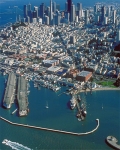| |
|
| |
| Port Name | |
Port of San Francisco |

Port of San Francisco | | State | |
California | | Total Trade | |
2,654,714 | | Foreign Imports | |
1,834,855 | | Foreign Exports | |
255,444 | | Foreign Total | |
2,090,299 | | Domestic Total | |
564,415 | | | | Description | |
The Port of San Francisco lies on the western edge of the San Francisco Bay near the Golden Gate. It has been called one of the three great natural harbors in the world, but it took two long centuries for navigators from Spain and England to find the anchorage originally called Yerba Buena. A port, as was said in its early days, in which all the fleets of the world could find anchorage.The larger waterfront area extends from the anchorage of the Golden Gate bridge through the Marina district all the way around the north and then east shore of the city of San Francisco to the city line beyond Candlestick Point.The Port of San Francisco is currently a semi-independent organization run by a five-member commission, appointed by the Mayor and approved by the Board of Supervisors.
| | | | Key Factor | |
The Board of State Harbor Commissioners was established in 1863 and set about the task of building a seawall on the San Francisco waterfront. The project that would eliminate the patchwork and jagged lines of the waterfront, ending it cleanly at the modern Embarcadero. After four years of litigation, the commissioners offered a thousand dollar prize for the best plan for the San Francisco Seawall. One of the designers of the plan, W.J. Lewis was appointed engineer in chief of the project. Another engineer on the project, T.J. Arnold designed the curving waterfront eventually settled on.A sixty foot wide pit or channel in the mudflats was dredged to a depth of twenty feet below low tide level and huge loads of rock were dumped in from scows and barges at the center line of the trench until they stopped sinking, to make an evenly graded ridge the whole way at the height of mean low tide. The rocks became the foundation for the seawall. Coffer dams were sunk and forms constructed inside them while constant pumping occurred. A mass of concrete two feet thick and ten feet wide was poured over the rocks and a masonry wall seven feet at the base and nine feet high was constructed. The area inside the wall was pumped out and filled with rock, rubble and trash to the city grade. It took the board several years to acquire the leases on private wharves.The opening of the First Transcontinental Railroad in 1869 halted harbor development and the building of the seawall. The tonnage of vessels arriving at the port dropped by nearly half in the next two years.By 1871, the commissioners could report that they were in possession of all the wharves along the city front except those that bordered Channel Street between Third and Fourth streets.In 1881, the Harbor Commissioners began contracting for the construction of the San Francisco seawall, The seawall would take fifty years before completion of the last sections in the China Basin.
|
|
